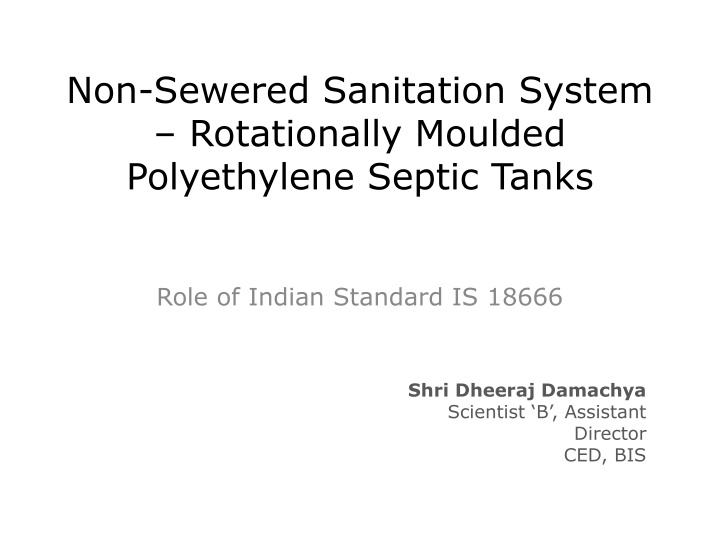
Role of Rotational Moulded Polyethylene Septic Tanks in Non-Sewered Sanitation Systems
Learn about the Indian Standard IS 18666 covering design, materials, and testing of rotationally molded polyethylene septic tanks. Explore key design specifications, application in on-site sanitation systems, and the structural strength required for underground installation. These septic tanks provide an alternative to traditional sewerage systems in both urban and rural areas, with the effluent requiring secondary treatment for proper disposal.
Download Presentation

Please find below an Image/Link to download the presentation.
The content on the website is provided AS IS for your information and personal use only. It may not be sold, licensed, or shared on other websites without obtaining consent from the author. If you encounter any issues during the download, it is possible that the publisher has removed the file from their server.
You are allowed to download the files provided on this website for personal or commercial use, subject to the condition that they are used lawfully. All files are the property of their respective owners.
The content on the website is provided AS IS for your information and personal use only. It may not be sold, licensed, or shared on other websites without obtaining consent from the author.
E N D
Presentation Transcript
Non-Sewered Sanitation System Rotationally Moulded Polyethylene Septic Tanks Role of Indian Standard IS 18666 Shri Dheeraj Damachya Scientist B , Assistant Director CED, BIS
Covers requirements for design, materials, size, performance, and testing of rotationally molded polyethylene (PE) septic tanks for underground installation. Tanks are suitable for standard temperature and pressure conditions. Excludes mechanisms for effluent disposal, which require treatment as 2470 (Part 2). Scope of IS 18666 further per IS
Application On-site sanitation systems, like septic tank systems, are alternatives to sewerage systems in areas where the latter is unfeasible or unavailable in both urban and rural areas. The septic tank effluent should be given secondary treatment either in a biological filter, up-flow anaerobic filter, on the land or in a sub-surface disposal system. centralized
Effective Volume and Nominal Size Minimum hydraulic retention time: 24 hours. Minimum sludge storage period: 2 years Minimum effective volume: 1,000 liters. Recommended dimensions ensure durability. Key Design Specificatio ns
Compartmentation and Flow Septic tanks over 2,000 liters must have 2 or more chambers with durable partitions. The first chamber s capacity must be at least twice that of subsequent chambers, with tops 100 mm above the water level for horizontal tanks. Partitions must maintain tank integrity and withstand mechanized desludging. Openings (100-150 mm wide) must be provided for inter- compartmental flow, with an optional up-flow transfer for improved efficiency. Key Design Specificatio ns
The tank is designed to withstand soil loads, hydrostatic pressures, and thermal variations. The Septic tank is tested for Durability, load bearing and structural strength. No structural failures under load-bearing tests. Structural Strength and Integrity Finish Free from visual defects ensuring durability.
Indian Standard IS 18797 Packaged Sewage Treatment Plant Load test for bearing capacity tank shall be done as per Annex H. 11
Type Test Type tests are intended to prove the suitability and performance of a Septic Tank of a new composition, a new technique, a new design, a new size or shape, or modified wall thickness. These shall also be done whenever a change is made in the raw material, raw material supplier or method of manufacture, or when a new design, size or shape of the septic tank is introduced. Tests Acceptance Test Acceptance tests are carried out on samples taken from the lot for the purpose of acceptance of the lot.
Key Parameters: Hydraulic efficiency: 99%. Water tightness: No leaks under specified conditions. Structural strength: Verified through load and impact tests. Test Requiremen ts
Installation: Follow manufacturer's guidelines for placement, pipe connections, and backfill material. Ensure ventilation and proper alignment. Installatio n & Maintenan Maintenance: Periodic desludging based on usage and capacity. Inspect and maintain structural integrity regularly. ce


